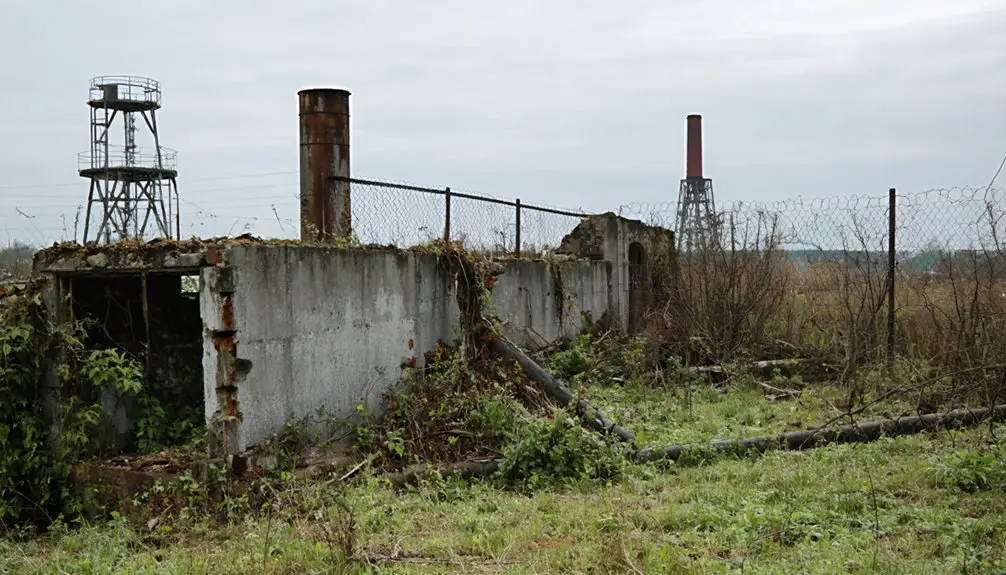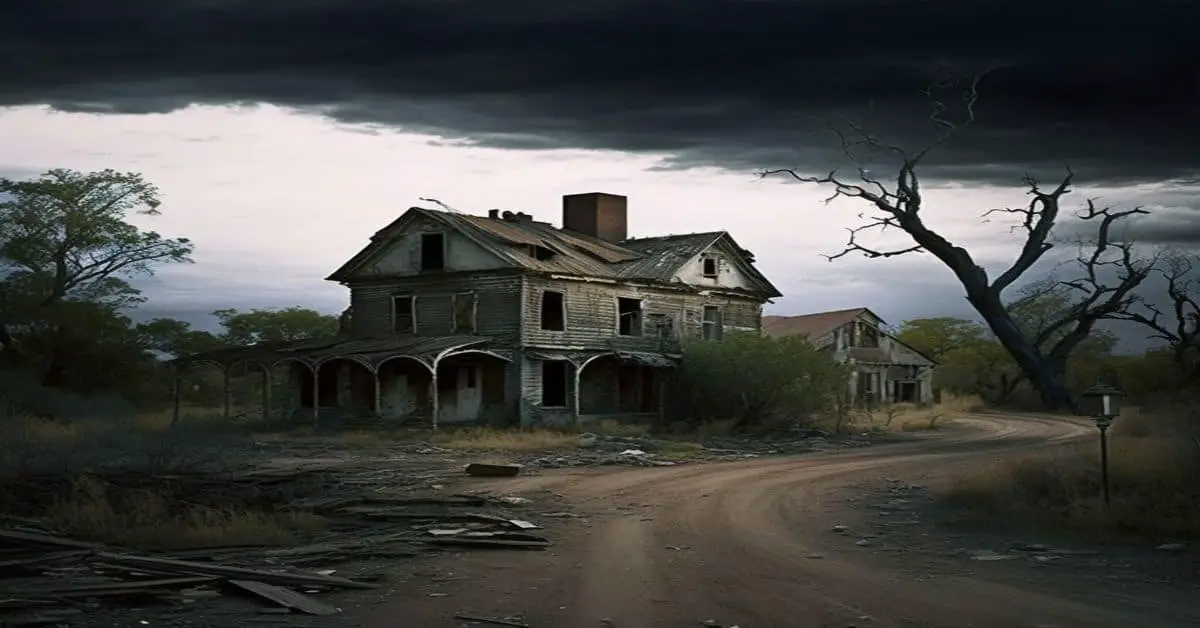You’ll find Wagner’s Point’s story in Baltimore’s industrial peninsula, where Martin Wagner established a thriving Polish immigrant community in 1883. The town grew from 600 to 2,000 residents, centered around oyster packing, St. Adalbert’s Church, and rich cultural traditions. But by the late 1990s, devastating environmental contamination from petrochemical companies forced the city to buy out 270 residents, transforming this once-vibrant neighborhood into an abandoned ghost town. The full tale reveals a community’s powerful fight for justice.
Key Takeaways
- Wagner’s Point, established in 1883, was a thriving Polish immigrant community built around oyster and fruit packing operations near Baltimore.
- The town featured 100 row houses, St. Adalbert’s Catholic Church, and a population that peaked at 2,000 residents.
- Industrial development, including oil refineries and chemical plants, led to severe environmental contamination of the area.
- The city initiated a buyout program in the late 1990s, relocating approximately 270 residents due to health and environmental concerns.
- After the community’s relocation, Wagner’s Point became an industrial ghost town, with ongoing environmental monitoring of contaminated sites.
The Birth of a Company Town
When Martin Wagner established his company town in 1883, he strategically chose the industrial Baybrook peninsula to build an integrated community around his oyster and fruit packing operations.
You’ll find that Wagner’s ambitious community development plan included expanding his industrial footprint with a wooden box factory and tin can plant, creating a self-sustaining manufacturing hub.
To support the growing labor dynamics, he constructed about one hundred East Baltimore-style row houses, primarily housing Polish immigrant workers.
Wagner’s workforce housing strategy included building rows of Baltimore-style homes that became home to Polish immigrant laborers.
Wagner’s vision transformed the point into a thriving industrial-residential enclave where production and daily life seamlessly merged.
The community quickly took shape with crushed shell streets spanning six blocks, while St. Adalbert’s Catholic Church and a parochial school provided spiritual and educational foundations for the workforce.
The population’s remarkable growth from 600 residents in 1897 to nearly 2,000 by the early 1900s demonstrated the success of Wagner’s industrial vision.
Tragedy struck when the Martin Wagner plant was destroyed by fire in 1913, marking a significant turning point for the community.
Polish Heritage and Community Life
You’ll find that Polish immigrants in Wagner’s Point preserved their cultural heritage through the establishment of St. Adalbert’s Catholic Church, where both Polish and English masses nurtured their dual identity.
The church, partially funded by Martin Wagner himself, became the heart of community life, hosting traditional celebrations and providing Polish language education through its parochial school. Families would often gather at the church before heading to bean picking camps during the summer harvest season.
St. Adalbert’s religious center fostered a strong sense of belonging among Polish families who gathered there for spiritual guidance, social events, and cultural preservation in their tight-knit Baltimore community. Like other Polish parishes established in Baltimore such as St. Stanislaus Kostka in 1880, St. Adalbert’s served as a cornerstone for maintaining Polish traditions and faith.
Polish Cultural Traditions Preserved
Throughout the late 1800s and early 1900s, Wagner’s Point’s Polish immigrant community maintained a rich cultural heritage through various social institutions and traditions.
St. Adalbert’s Church, with its gothic revival style architecture, stood as a beloved symbol of the community’s cultural identity.
You’d find vibrant cultural gatherings at places like the Polish Home Hall in Curtis Bay and the Polish Home Club in Fell’s Point, where residents celebrated their heritage through music, dance, and traditional culinary festivals.
The community preserved their native language through Polish-language newspapers and church services at St. Adalbert’s, where both Polish and English were used.
These cultural hubs hosted regular fundraising events like oyster roasts, helping sustain the spaces where Polish Americans could freely express their identity.
Local organizations, including savings and loans societies, supported newcomers while ensuring cultural traditions passed to future generations.
St. Adalbert’s Religious Center
St. Adalbert’s Catholic Church emerged in 1907 as your community’s spiritual backbone when Martin Wagner donated $10,000 and land to serve his Polish workforce.
Under Father Charles Kotlarz’s dedicated leadership, you’d find this sacred space hosting vibrant community gatherings in both Polish and English, uniting two-thirds of Wagner Point’s Polish immigrant families. Like many historic parishes experiencing significant decline since the 1960s, St. Adalbert’s struggled with changing demographics.
You could witness the church’s influence beyond religious services, as it operated a parochial school that preserved your Polish traditions. The parish grew from 350 to 700 souls between 1893 and 1903, reflecting the expanding Polish community.
During community cultural events, you’d join fellow parishioners who shared your working-class struggles and industrial ties.
Despite economic hardships, including the devastating 1913 cannery fire, you’d find strength in the church’s tight-knit fellowship until its closure in 1967 and tragic burning in 1968.
Industrial Growth and Environmental Changes
As you explore Wagner’s Point’s transformation from a bustling cannery town, you’ll find the 1912 Wagner factory fire marked a pivotal shift toward heavy industrial development, with oil refineries and chemical plants replacing the original seafood operations.
You’ll see how these new industries brought devastating environmental impacts, including the 1920 United States Asphalt Refining Company fire that flooded streets with burning oil and destroyed 32 homes. The Patapsco Waste Water Treatment Plant now operates where the former Martin Wagner Company once stood.
The neighborhood’s industrial footprint continued to expand through the mid-20th century, leading to severe air pollution and toxic contamination that would ultimately force residents to abandon their homes by the late 1990s. After lengthy negotiations, the city bought out approximately 270 residents who lived in the area.
Industrial Complex Expansion
While Martin Wagner’s initial industrial ventures laid the groundwork in 1883, Wagner’s Point rapidly evolved into a thriving industrial complex that transformed the peninsula’s landscape.
You’ll find a representation of industrial resilience in how the area grew from a simple canning operation to include wooden box and tin can manufacturing facilities, showcasing remarkable vertical integration. The Martin Wagner plant was ultimately destroyed by a devastating fire in 1913.
The community’s adaptation was evident as the population surged from 600 to 2,000 residents by the 1910s.
- Strategic maritime location enabled efficient shipping and material handling
- Railroad connectivity boosted logistical capabilities and regional access
- Polish immigrant workforce formed a tight-knit industrial community
- Company-owned housing and amenities created a self-sustaining ecosystem
- Industrial footprint expanded through calculated capital investments, replacing leisure properties
Toxic Environmental Legacy
Despite Wagner’s Point’s industrial success through the early 1900s, the community paid a devastating environmental price that would ultimately lead to its downfall. The area’s toxic legacy began with a series of catastrophic industrial accidents, including the 1912 cannery fire, 1920 oil refinery blaze, and 1927 munitions explosion that displaced hundreds of families.
You’ll find the environmental destruction intensified as petrochemical companies, oil tank farms, and Baltimore’s largest medical waste incinerator clustered around this working-class neighborhood.
Health Crisis and Rising Concerns
Throughout the early 2000s, Wagner’s Point residents faced mounting health challenges that threatened their community’s well-being. The area’s health crisis mirrored broader Baltimore City trends, with chronic diseases and mental health concerns rising at alarming rates.
You’ll find that high blood pressure affected nearly 40% of the local population, while substance abuse and mental health issues created additional burdens on an already strained community.
- Skyrocketing rates of heart disease and hypertension among residents
- Limited access to healthcare due to transportation and insurance barriers
- Rising mental health concerns with inadequate support services
- Discrimination in healthcare settings hampering proper treatment
- Substance abuse challenges affecting 36-50% of the population
These health challenges, compounded by environmental factors, led to increased vulnerability in Wagner’s Point’s remaining residents.
The Fight for Relocation

The mounting health crisis in Wagner’s Point ignited a fierce battle for relocation that would reshape the community’s future. Led by community activist Jeannette Skrezecz, residents displayed remarkable resilience as they fought against environmental injustice.
After Skrezecz’s death from cancer in 1998, the community intensified their campaign, refusing to remain invisible.
You’ll find their legal strategies were multi-pronged: they charged seven local companies with federal violations, picketed City Hall, and secured essential meetings with officials.
Their persistence paid off when Senator Barbara Mikulski championed a $750,000 federal allocation.
Though negotiations remained tense, with residents even staging a walkout in September 1998, their determination prevailed.
Through coordinated efforts across federal, state, and city levels, the community finally secured their long-sought relocation commitment by year’s end.
Baltimore City’s Buyout Program
After years of intense community activism, Baltimore City launched an ambitious buyout program targeting Wagner’s Point’s residential areas in the late 1990s.
You’ll find that buyout negotiations weren’t smooth sailing – with about 270 residents showing fierce community resistance, including dramatic walkouts during 1998’s heated discussions.
- Over $5 million in donated legal and business services supported families
- Maryland Home Financing Program provided essential relocation assistance
- City leveraged foreclosures alongside negotiations to acquire properties
- Local industries and community coalitions joined forces to support the shift
- Additional matching grants up to $3,000 incentivized new homebuyers elsewhere
The program ultimately succeeded through strategic partnerships with local foundations, banks, and community groups.
Together, they created a thorough support system that helped residents relocate while preserving their dignity and financial stability.
From Neighborhood to Ghost Town

Wagner’s Point’s transformation from a vibrant neighborhood to an industrial ghost town began well before the buyout program sealed its fate.
Despite the community’s resilience in facing mounting environmental challenges, the 1960s and 70s brought undeniable health concerns as cancer rates climbed among residents.
You’d have seen the neighborhood’s decline accelerate as heavy industry hemmed in the remaining families, with chemical storage facilities and sewage treatment plants dominating the landscape.
Environmental Impact and Brownfield Status
Decades of industrial activity left an indelible mark on Wagner’s Point‘s environment, with a former BP Amoco petroleum terminal and asphalt refinery contributing to widespread soil and groundwater contamination.
You’ll find this legacy site now under Maryland’s Voluntary Cleanup Program, reflecting ongoing efforts to address contamination risks through community engagement and regulatory oversight.
- Major cleanup operations conducted during 2002-2003 targeted hazardous waste
- Site received “No Further Requirements Determination” certification in 2004
- Recent Environmental Site Assessments in 2023 identify remaining challenges
- Public meetings keep residents informed of redevelopment progress
- Long-term monitoring continues due to persistent soil and groundwater issues
The environmental impact prompted health-based relocations, as residents faced higher rates of cancer and chronic illnesses.
Today, the site’s transformation into a commercial property symbolizes both the area’s industrial past and its potential for renewal.
Preserving Wagner’s Point’s Story

Through dedicated preservation efforts, the rich history and cultural legacy of Wagner’s Point lives on in various forms of documentation and storytelling.
You’ll find archival preservation spanning from 1880s photographs to modern digital mapping initiatives, capturing the neighborhood’s evolution from a thriving company town to its eventual displacement.
Community narratives, particularly from Polish-American families, paint vivid pictures of life amid industrial encroachment.
Former residents’ oral histories detail their struggles with pollution, health issues, and the emotional toll of relocation.
University researchers and environmental justice advocates have documented these experiences through dissertations, legal memorials, and academic studies.
Today, digital platforms share these stories alongside historical photographs and maps, while local historians organize virtual tours and gatherings to keep Wagner’s Point’s memory alive for future generations.
Frequently Asked Questions
What Happened to St. Adalbert’s Church Building After Wagner’s Point Was Abandoned?
You won’t find St. Adalbert’s history continuing past 1967, as there’s no record of church restoration. After closure, the building likely faced demolition amid Wagner’s Point’s decline, with no documentation of preservation.
Did Any Original Wagner’s Point Buildings Survive the Demolition Process?
After relocating 300 residents, you won’t find any historical preservation or architectural remnants today – every single original building was demolished between 2000-2005 due to severe environmental health concerns.
Where Did Most Wagner’s Point Residents Relocate to After the Buyout?
You’ll find most residents stayed within Baltimore City’s safer residential areas, though relocation patterns scattered the tight-knit community. They sought neighborhoods away from industrial zones to escape environmental health risks.
What Current Security Measures Exist to Prevent Trespassing in Wagner’s Point?
Patrolling police and protective perimeters keep you out through heavy security patrols, trespassing laws, industrial fencing, surveillance cameras, and no-entry signs around the contaminated zone’s secured wastewater treatment plant and chemical facilities.
Are There Any Annual Reunions or Gatherings of Former Wagner’s Point Residents?
You won’t find documented annual gatherings of former residents today. While community memories remain strong, the dispersal after the 1990s buyouts effectively ended organized reunions of Wagner’s Point’s displaced community.
References
- https://www.ronaldtanner.com/baltimores-ghost-town/
- https://mappingbaybrook.org/2018/03/wagners-point/
- https://somatosphere.com/2020/toxic-disavowal.html/
- https://www.ghosttowns.com/states/md/wagnerspoint.html
- https://kids.kiddle.co/List_of_ghost_towns_in_Maryland
- https://msa.maryland.gov/megafile/ecp/26/037/html/olson11.html
- https://baltimoretraces.umbc.edu/files/2021/03/King_preserving_places_JUH.pdf
- https://dbpedia.org/page/Wagner’s_Point
- https://en.wikipedia.org/wiki/Wagner’s_Point
- https://en.wikipedia.org/wiki/History_of_Poles_in_Baltimore



